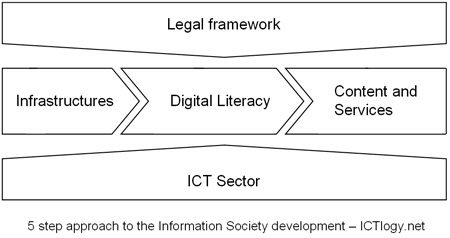I’ve been working lately analyzing 47 models that describe — explicitly or implicitly — the Information Society. Some of them speak of access as the existence of infrastructures; other cannot conceive any effective access without capacity (i.e. digital skills); some others do have quite a broad understanding of what access is and include many nondigital/analogue variables to explain their model.
On one hand, all models (or almost) have their reasons: depending on what are your objectives, you are measuring a different thing and/or think of different conceptions of the Information Society — and the digital divide.
On the other hand, the problem is that this is just like speaking in different tongues, a Babel Tower, where quite often people, institutions, projects, indicators and indices, etc. do tell different and incomparable things.
Almost two years ago I draw what I then considered a framework that could gather up all kind of approaches:

I’ve now drawn the following one:
If you need to cite this article in a formal way (i.e. for bibliographical purposes) I dare suggest:
Peña-López, I. (2008) “Towards a comprehensive model of the Digital Economy” In ICTlogy,
#59, August 2008. Barcelona: ICTlogy.
Retrieved month dd, yyyy from
https://ictlogy.net/review/?p=954
Previous post: The digital war on poverty is not won. A comment to Jeffrey Sachs
Next post: Third Annual ICT4D Postgraduate Symposium (I). Tim Unwin: ICT4D – where next?
5 Comments to “Towards a comprehensive model of the Digital Economy” »
 RSS feed for comments on this post.
TrackBack URI
RSS feed for comments on this post.
TrackBack URI



I think the second diagram needs your explanation, as it doesn’t look self-explanatory to me, especially the demand-supply-flows-assets sides.
Benvolgut Ismael,
crec que el quadre primer, certament, és massa simple avui en dia i, sobretot, diria que sobredimensiona el marc legal. Però probablement és més entenedor que el segon.
Del segon, comparteixo molt el paper central de la formació en competències digitals. També et diria que la “disponibilitat” potser no és una categoria de la mateixa naturalesa que els altres que proposes.
Igual que Paolo, penso que l’esquema necessita la teva explicació. M’ha donat la impressió que la simetria formal s’imposa una miqueta a l’estructura conceptual que planteges: hi ha moltes coses que no em lliguen (segurament perquè no les entenc prou).
De totes maneres, l’esforç de sÃntesi em sembla magnÃfic. Moltes grà cies per l’aportació.
I, naturalment, n’esperem amb interès el desplegament!
Molt cordialment,
Boris
Paolo, Boris: yes, it does need more info. I just have to gather some time here and there ;)
According to that new and detailed framework, Digital Literacy Training seems to play a central role, being the most connected factor and somehow the previous condition for some others (like affordability of infrastructures or use of contents/services). But why “Training” and not “Learning” (something that would include self-learning)?
It’s great that you still find time there and there for sharing this kind of things :)
Training vs. learning… that’s a good point that without any doubt will be including in my next version. Thank you so much, Enric.
And yep, I’ll be finding some time… soon? ;)